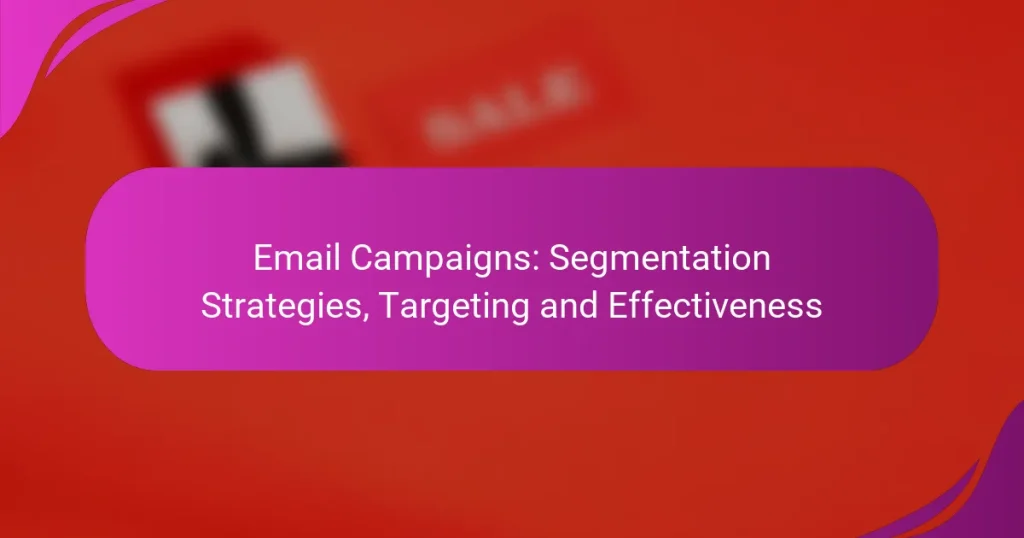Email campaigns can achieve greater effectiveness through strategic segmentation, which involves categorizing your audience based on demographics, behaviors, and preferences. By tailoring your messages to resonate with specific segments, you enhance engagement and drive better results. Utilizing the right tools can further streamline this process, allowing for personalized content and automated targeting that boosts conversion rates.
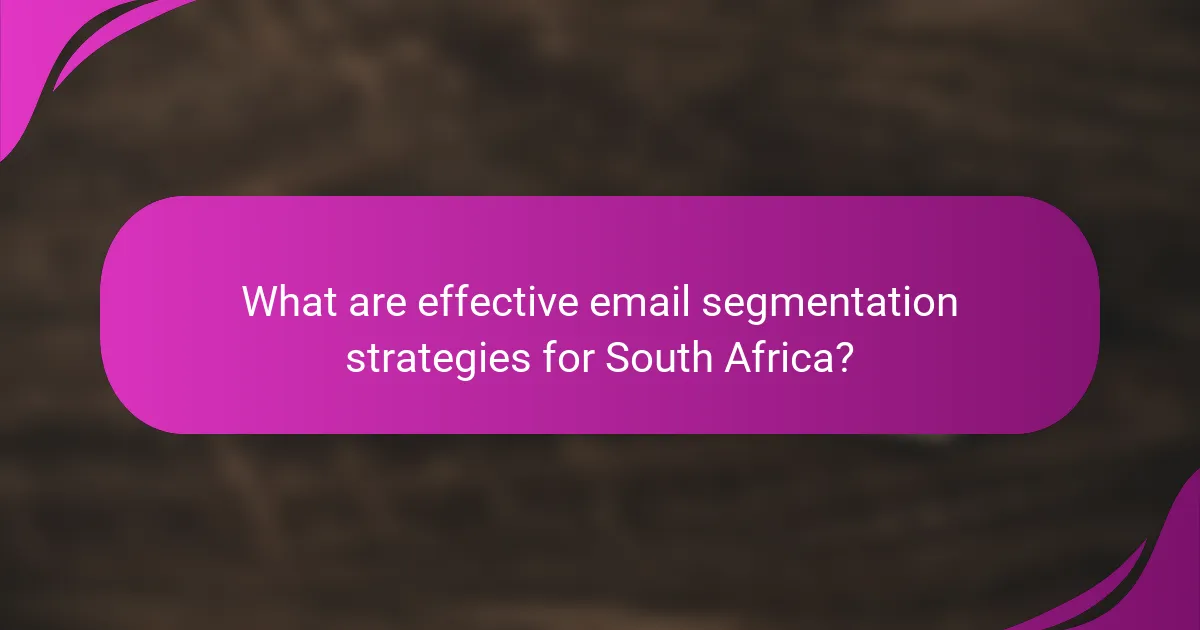
What are effective email segmentation strategies for South Africa?
Effective email segmentation strategies in South Africa involve categorizing your audience based on specific criteria to enhance targeting and engagement. By understanding your subscribers’ demographics, behaviors, locations, and preferences, you can tailor your campaigns for better results.
Demographic segmentation
Demographic segmentation focuses on characteristics such as age, gender, income, and education level. In South Africa, this can help you create targeted messages that resonate with specific groups, such as millennials or retirees. For example, a campaign promoting financial services may be tailored differently for younger audiences compared to older individuals.
Consider using data from surveys or customer profiles to identify key demographic groups. This information can guide your content, tone, and offers, ensuring they align with the interests of each segment.
Behavioral segmentation
Behavioral segmentation analyzes how subscribers interact with your emails, including open rates, click-through rates, and purchase history. This strategy allows you to target users based on their actions, such as frequent buyers or those who abandon carts. For instance, you might send personalized reminders to customers who left items in their shopping carts.
Utilizing analytics tools can help you track these behaviors effectively. Regularly updating your segments based on user activity ensures your campaigns remain relevant and engaging.
Geographic segmentation
Geographic segmentation divides your audience based on their location, which is crucial in a diverse country like South Africa. Factors such as urban versus rural settings can influence purchasing behavior and preferences. For example, marketing a product that is popular in Johannesburg may not have the same appeal in smaller towns.
Tailoring your messaging to reflect local culture, language, and even seasonal events can enhance engagement. Consider using localized offers or promotions to attract specific regions.
Psychographic segmentation
Psychographic segmentation delves into the interests, values, and lifestyles of your audience. Understanding what motivates your subscribers can help you craft messages that resonate on a deeper level. For instance, campaigns targeting environmentally conscious consumers might highlight sustainable practices or eco-friendly products.
To gather psychographic data, consider conducting surveys or utilizing social media insights. This information can guide your content strategy, ensuring it aligns with your audience’s beliefs and preferences.
Firmographic segmentation
Firmographic segmentation applies to B2B email campaigns, categorizing businesses by size, industry, revenue, or location. In South Africa, this can help you tailor your messaging to specific sectors, such as retail or manufacturing. For example, a software solution may be marketed differently to small startups versus large corporations.
Utilizing databases or industry reports can aid in identifying key firmographic characteristics. This approach allows for more relevant content and can improve conversion rates by addressing the unique challenges faced by different businesses.
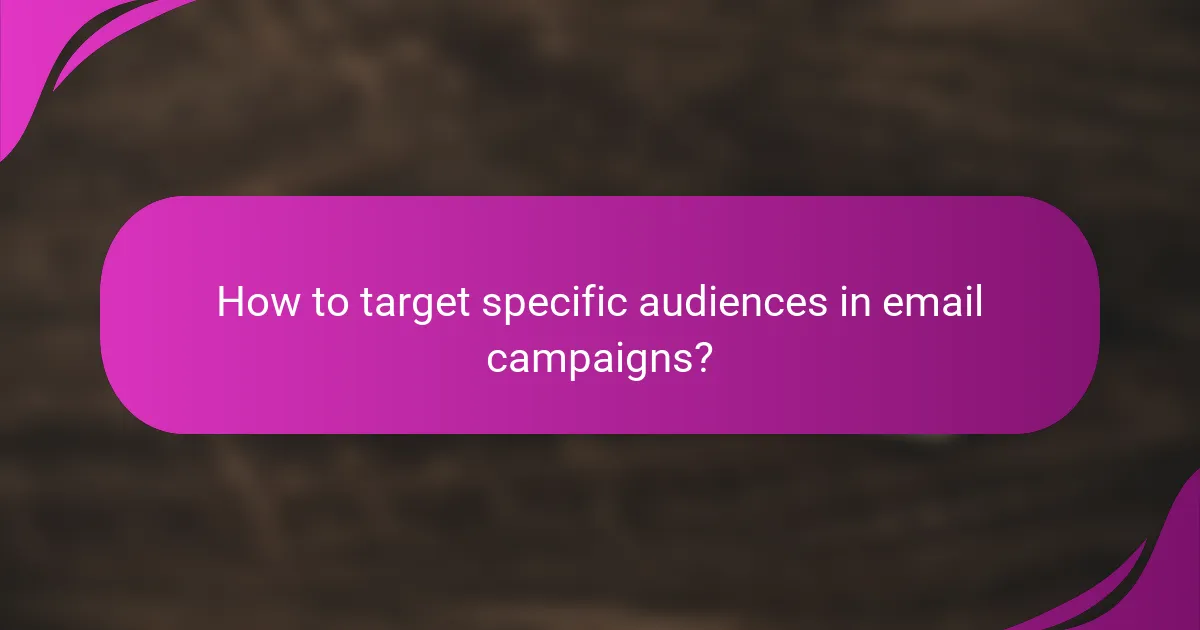
How to target specific audiences in email campaigns?
To effectively target specific audiences in email campaigns, it’s crucial to understand their preferences and behaviors. This involves segmenting your audience based on various criteria to ensure your messages resonate with their needs and interests.
Utilizing customer personas
Customer personas are fictional representations of your ideal customers based on data and research. By creating detailed personas, you can tailor your email content to address the specific motivations, challenges, and preferences of different segments. For instance, a persona for a budget-conscious shopper might receive promotions focused on discounts and value.
To develop effective personas, gather data from surveys, interviews, and analytics. Aim for a diverse range of personas to cover various demographics, interests, and buying behaviors, ensuring your campaigns can appeal to a broad audience.
Leveraging purchase history
Analyzing purchase history allows you to identify trends and preferences among your customers. By segmenting your audience based on their past purchases, you can send targeted emails that promote related products or services. For example, if a customer frequently buys outdoor gear, you can send them updates on new arrivals in that category.
Consider implementing automated email triggers based on specific actions, such as abandoned carts or repeat purchases. This approach not only enhances relevance but can also significantly improve conversion rates by reminding customers of their interests.
Implementing engagement metrics
Engagement metrics, such as open rates, click-through rates, and conversion rates, provide valuable insights into how your audience interacts with your emails. By tracking these metrics, you can identify which segments are most responsive and adjust your targeting strategies accordingly. For instance, if a particular group shows high engagement with promotional content, you can focus on sending them more offers.
Regularly review and analyze these metrics to refine your segmentation strategies. Avoid relying solely on one metric; instead, consider a combination of factors to get a comprehensive view of your audience’s engagement and preferences.
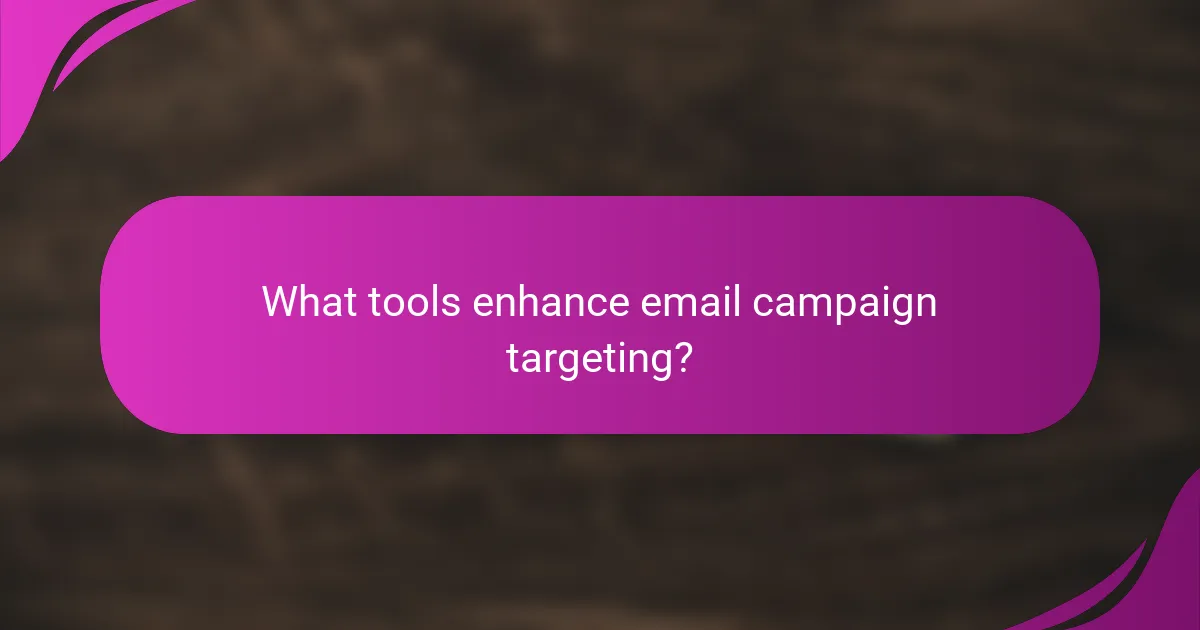
What tools enhance email campaign targeting?
Effective email campaign targeting can be significantly improved with the right tools. These platforms offer features that allow marketers to segment their audience, personalize content, and automate processes, leading to higher engagement and conversion rates.
Mailchimp for segmentation
Mailchimp excels in audience segmentation, enabling users to create targeted groups based on various criteria such as demographics, purchase history, and engagement levels. This allows for tailored messaging that resonates with specific segments, improving open and click-through rates.
To effectively use Mailchimp for segmentation, start by importing your contact list and utilizing its built-in segmentation tools. Consider segmenting by factors like location, past purchases, or engagement frequency to ensure your campaigns are relevant and timely.
HubSpot for audience targeting
HubSpot provides robust audience targeting capabilities, allowing marketers to define and refine their target audience through detailed buyer personas. This helps in crafting personalized content that speaks directly to the needs and interests of potential customers.
Utilizing HubSpot’s targeting features involves analyzing user behavior and engagement metrics. Regularly update your personas based on new data to keep your targeting accurate and effective, ensuring that your email campaigns reach the right people at the right time.
ActiveCampaign for automation
ActiveCampaign stands out for its automation features, which streamline the email marketing process by sending targeted messages based on user actions. This allows for timely follow-ups and personalized communication without manual intervention.
To leverage ActiveCampaign’s automation, set up triggers based on user interactions, such as website visits or email opens. This ensures that your audience receives relevant content that aligns with their journey, enhancing engagement and driving conversions.
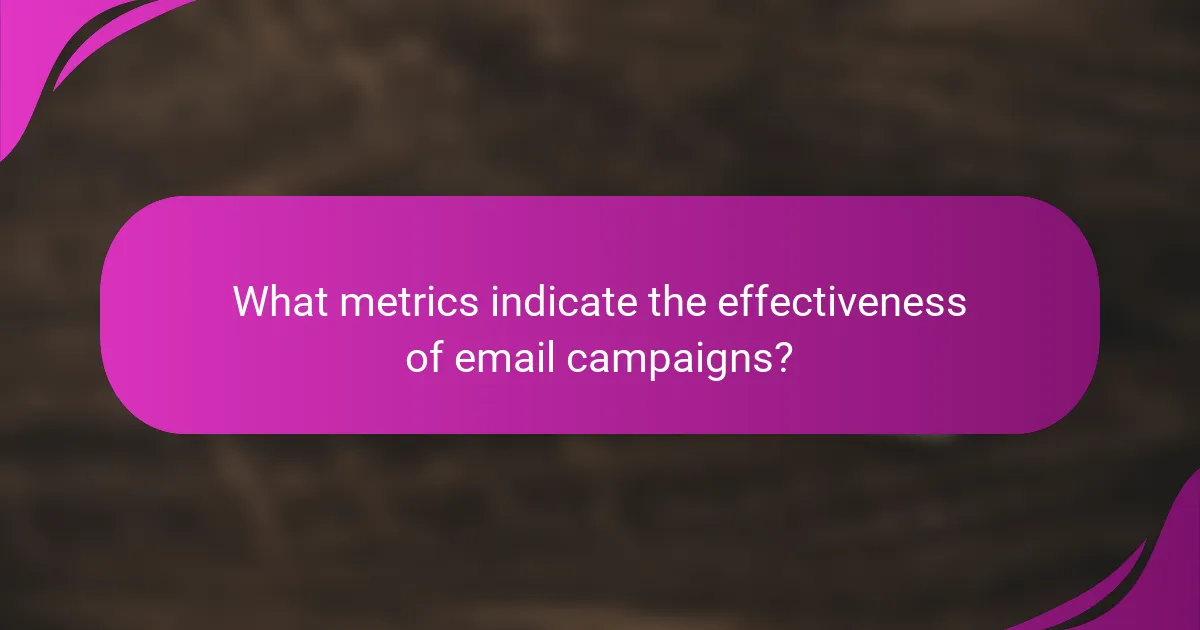
What metrics indicate the effectiveness of email campaigns?
The effectiveness of email campaigns can be gauged through several key metrics, primarily open rates, click-through rates, and conversion rates. These indicators help marketers assess engagement and the overall success of their campaigns in achieving desired outcomes.
Open rates
Open rates measure the percentage of recipients who open an email compared to the total number of emails delivered. A typical open rate can range from 15% to 30%, depending on the industry and the quality of the email list. High open rates often indicate effective subject lines and targeted audience segmentation.
To improve open rates, consider personalizing subject lines and sending emails at optimal times based on your audience’s behavior. Avoid spammy language and ensure your sender name is recognizable to increase trust and engagement.
Click-through rates
Click-through rates (CTR) represent the percentage of recipients who click on one or more links within the email. A good CTR usually falls between 2% and 5%, but this can vary by industry and campaign type. High CTRs suggest that the content resonates with the audience and encourages them to take action.
To boost click-through rates, include clear calls to action (CTAs) and ensure that links are easily accessible. A/B testing different layouts and messaging can also help identify what drives more clicks.
Conversion rates
Conversion rates indicate the percentage of email recipients who complete a desired action, such as making a purchase or signing up for a newsletter. Typical conversion rates can range from 1% to 5%, depending on the campaign’s goals and the audience’s readiness to engage. High conversion rates reflect effective targeting and persuasive content.
To enhance conversion rates, focus on creating compelling offers and ensuring a seamless user experience from the email to the landing page. Monitor and analyze the customer journey to identify any barriers that may prevent conversions.
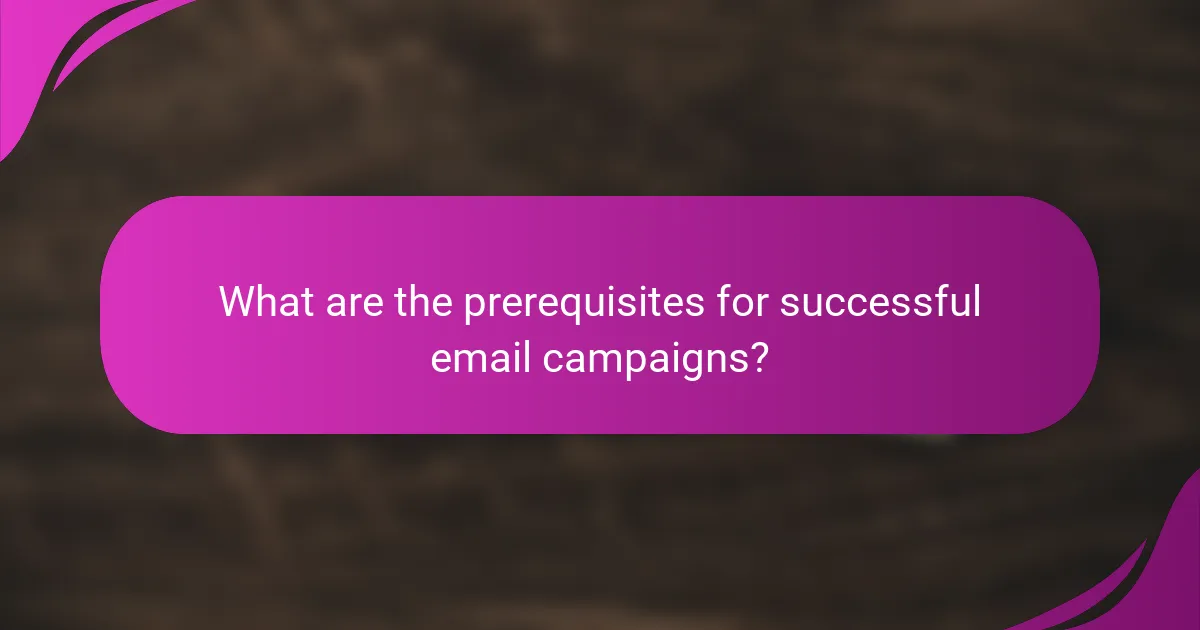
What are the prerequisites for successful email campaigns?
Successful email campaigns require a clear strategy, a well-defined target audience, and effective segmentation. Understanding these prerequisites helps ensure that your messages resonate with recipients and achieve desired outcomes.
Understanding Your Audience
To effectively target your email campaigns, you must have a deep understanding of your audience. This includes demographics, preferences, and behaviors. Utilize surveys, website analytics, and customer feedback to gather insights that inform your segmentation strategy.
Segmenting your audience based on these insights allows for tailored messaging that speaks directly to their needs. For example, a clothing retailer might segment customers by age group, tailoring promotions to young adults versus older consumers.
Data Collection and Management
Effective email campaigns rely on accurate and comprehensive data collection. Implement systems to gather email addresses and relevant customer information while ensuring compliance with regulations like GDPR or CAN-SPAM. This data should be regularly updated to maintain its accuracy.
Consider using Customer Relationship Management (CRM) tools to manage and segment your data efficiently. This can help you maintain organized lists and track engagement metrics, which are crucial for refining your campaigns.
Segmentation Strategies
Segmentation strategies involve dividing your email list into specific groups based on shared characteristics. Common strategies include demographic segmentation, behavioral segmentation, and psychographic segmentation. Each method allows for more personalized communication.
For instance, a travel agency might segment its audience based on travel preferences, such as adventure seekers versus luxury travelers, enabling them to send tailored offers that resonate with each group.
Testing and Optimization
Testing and optimization are vital for improving the effectiveness of your email campaigns. A/B testing different subject lines, content formats, and send times can provide insights into what resonates best with your audience.
Regularly analyze engagement metrics such as open rates and click-through rates to identify trends and areas for improvement. Use this data to refine your segmentation and messaging strategies continuously.
